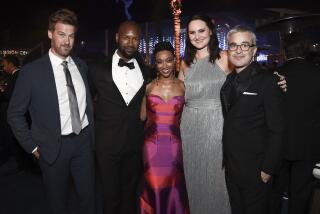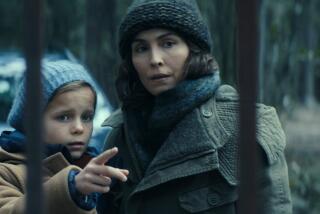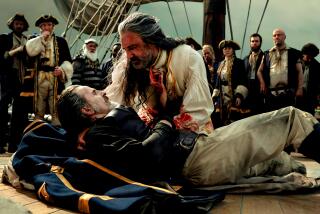‘Battlestar’s’ last roundup
Admiral Adama arrived at the door with blood on his hands. “I’m sorry, I don’t think you want me to shake,” actor Edward James Olmos said, presenting his red palms. With his world-weary eyes and the stained cuffs of his military coat, he looked like some battlefield surgeon fresh from triage.
Inside his dressing-room trailer, the star of the relentlessly bleak “Battlestar Galactica” washed his hands and apologized again. “And I can’t tell you why I look like this.” Olmos had just walked off the set of “Battlestar,” which begins its fourth season on the Sci Fi Channel Friday night. More importantly, it’s also the final season, and its creators have zealously guarded the plot twists.
“I can’t even tell you whose blood it is,” Olmos said with a wink, beginning to enjoy the fun. It’s unusual to see Olmos smile when he’s in his William Adama role: He’s a sort of Churchill-in-space, trying to rally his people in the face of tremendous casualties and despair and also lead them on a quest for a fabled lost colony called Earth. Their struggle, for better or worse, is almost over. There are only 20 more episodes to sort out who will live, who will die and who will be outed as sleeper agents of the Cylons, the synthetic race that was created by humans and now aspires to push them out of existence.
Under slate-gray Canadian skies late last year, the cast of one of the most admired (and, according to the cruel math of ratings, one of the most undervalued) shows on television seemed to be mentally exhausted, anxious and sad. That’s understandable given the show’s looming end. They’ve lived through the annihilation of humanity for five years, but that doesn’t make it any easier to say goodbye.
“It is difficult to move on, but it is the correct time, the natural pace of the story -- there’s the beginning, the middle, and now it’s time for the end,” Olmos said. “We have hit so many notes, and now it’s time to tie everything up.”
Olmos has the wounded stare, craggy features and broad shoulders that look most comfortable in a posture of grief -- he has the ideal profile for “Battlestar,” which presents a human civilization reduced to under 50,000 souls and a fleet of spaceships on the run. The lead ship is the Galactica, which like its leader Adama, has been un-retired in desperation after a sneak attack by the Cylons. That’s the story arc, but the show’s great distinctions are its wonderfully flawed characters and the religious, social and political questions that float by as they swim in the show’s dire straits. Early on, series executive producer Ronald D. Moore wrote a mission statement for the planned “Galactica” series that pledged to break the standard sci-fi space-opera model and strive for a near-documentary texture, a sophisticated ambiguity to the stories and plenty of complications that the audience would recognize from the real world. Think you have unshakable opinions on the nature of suicide bombers, terrorism and torture? Try watching them tested in an alien atmosphere.
“The show is a dark mirror,” Olmos said. “So, so dark. I was talking to one of the executives on the show recently and this person told me that they would never do something like this again, this kind of material. I have been doing this a long time, working in television, film, the theater, and this is the best material I’ve ever worked on in my life.”
Others agree. It won a 2005 Peabody Award, the same year Time magazine named it the best show on television. It’s picked up an Emmy, a Hugo and a shelf full of Saturn Awards as well. But it is also a very expensive series to mount, and as Jamie Bamber, who portrays Lee “Apollo” Adama, the son of the Galactica’s leader, points out: “People who watch it say they love it. People who don’t watch it say they’ve heard great things and they should watch it. The show is a success, but not as big a hit as people think, not in the commercial sense.”
Many of the younger cast members such as Bamber and Tahmoh Penikett, who portrays Karl “Helo” Agathon, seem ready to shed their Galactica flight suits, pack up the industry credibility earned by their work on “Battlestar” and use it in places where they will be seen more.
“The end is in sight, for better or worse,” said the London-born Bamber. “Every time I come to Vancouver now there will be a sort of Proustian element and a Pavlovian response. I’ll think of my children being very young here, this stage and set, coming to North America, the sights and sounds. It will all be ‘Battlestar.’ ”
Penikett was less sentimental: “There is a lot of television out there, and a lot of it is bad, but still it feels like time to head toward the horizon.”
Olmos knows that feeling; he was a scene-stealing supporting character in the 1980s on “Miami Vice,” and he’s familiar with the stirring sensation that it’s time to seek the next role, the next big show. But he said the stars, producers and writers may find that they miss “Battlestar” even more later. “The people involved don’t know how special it is,” he said. “In 20 years, I think they will look back and realize what it was.”
The secret society
AS a journalist, it’s odd to visit a television show in production where a publicist literally jumps up to cover your eyes with her hand whenever you go near the set. “Sorry! You can’t look in here! Here, come this way . . . be careful, don’t trip.” The blindfold treatment is understandable: “Battlestar” fans include a zealous sect of sci-fi devotees who spend hours and hours analyzing every nuance and will send any spoiler or rumor pinging across the globe.
“The fans take it very seriously, which is nice,” Penikett said. “A lot of the hard-core fans, I have to say, don’t get out too much. And they’re lacking certain social graces.”
It was in deference to sci-fi genre fans that the show has the “Battlestar” moniker, which gave it instant name recognition with the crowd that dresses up like wookies or wear Spock ears at conventions. The first series called “Battlestar Galactica” was a show by Glen A. Larson, who had a career habit of creating successful but fairly derivative shows. His “B.J. and the Bear” was a lot like “Every Which Way But Loose,” for instance, while “Alias Smith and Jones” was slagged as a rip-off of “ Butch Cassidy and the Sundance Kid,” and “The Fall Guy” reminded everyone of “Hooper.” His “Galactica” premiered in 1978, a year after “Star Wars” created a cultural sensation, and it’s mainly remembered in the popular mind for featuring Lorne Greene, a fuzzy robot dog and slow, shiny Cylons who appeared to be playing Pong with their red-dot eyes. With that legacy, Olmos didn’t exactly jump at the pitch to revive the franchise.
“To me, it was ‘Star Trek’ and ‘Star Wars,’ so it was a knockoff of a knockoff. And so this new idea was going to be a remake of a knockoff of a knockoff? But then I read the script. This was in 2003, and it was completely informed by 9/11.”
The modern show is to the original as “Lost” is to “Gilligan’s Island.” It has a dense web of a story and a huge cast of characters that make it a challenge for anyone late to the game. Another cast member, Tricia Helfer, who plays Cylon No. Six, describes “Battlestar” like an English Lit major who is worried about the final.
“I feel like I need to study more when I talk to the fans, the questions and comments they have. This show is on the pulse of what is going on in our society. It’s not for couch potatoes flipping through the channels. If you’re not engaged, you get lost.”
That’s hardly a commercial to win the show a last-season surge of new viewers, but “Battlestar” isn’t about to turn superficial. It also has some of the most interesting female characters on television, chief among them Mary McDonnell as President Laura Roslin, a character who has dealt with a terminal cancer diagnosis, religious visions, an intense showdown with Adama and the difficult decision to go against her principles and outlaw abortion -- a decision made because of the statistics that show the human race is dying faster than it is propagating. “The show has never shied away from the most wrenching issues,” McDonnell said. “In fact, that’s what the show is all about.”
For this final season, the cast and crew filmed most of it before the writers strike and then sat and fretted that the labor dispute might sabotage the fragile plan to wrap up the show in 20 episodes. It’s still not clear how the delayed production will affect the airdates of the final season -- the completed first 10 will air during this run. (“There was a moment where I thought we might not be able to finish the story at all,” Olmos said in Los Angeles a few weeks ago. “That was a frightening thought. To leave all this unfinished would just be awful.” He also said that the notion of a “Battlestar” film wasn’t an option. “Glen Larson has the rights. If they make a ‘Battlestar’ film at some point, it won’t be these actors and this story, I know that.”)
The cast and crew assembled in Canada last week to shoot their last hurrah. Bamber said it’s clear from the first half of the season that there will be far more running than reflection in this final act.
“There are no lulls anymore,” Bamber said on the Vancouver set last year. “In previous years, there had been sequences where you could kind of sense that we were in an eddy at the side of the stream and we were just exploring an angle of the fleet that we just had not considered yet. There’s no available time for anything like that now.”
There’s something going on in pop culture right now with apocalyptic entertainments about the human race. “I Am Legend,” “Children of Men,” “28 Days Later” and “Doomsday” have all handled the end-times with degrees of grace and horror, and novelist Cormac McCarthy’s “The Road” reaches the screen this year. And “Battlestar” now has a finish line.
“If anything, I think the show was a little too early,” Olmos said. “But I also don’t think it could be made again. The political topics have just been too touchy. This is the world we live in, though. We’re an inch away from the edge. We feel it. We want to think about it and talk about it and watch it.”
Genre fans, of course, want to talk about it more than anyone else, and “Battlestar” is one of their most beloved topics. Entire conventions are devoted to the show and its heavy religious themes and heartthrob stars. The fan attention can become a bit much. Grace Park, who plays a collective of Cylon characters (Sharon/Boomer/Athena), said she recently got “a box big enough to fit a golden retriever in” that was packed with intricately assembled scrapbooks. “This fan had clearly spent hours and hours putting this together, and every page was about me, all the places where my name has popped up in a story or on the Internet. This story will be in the next one, I’m sure of it. It’s very nice, but it’s also a little . . . much.”
A ‘Trek’ not taken
OLMOS could have been sitting on the bridge of a different spaceship. “When they remade ‘Star Trek’ in the 1980s they called me about the lead,” Olmos said, referring to the Enterprise command that went to Patrick Stewart. “I wasn’t interested. Science fiction wasn’t really where I wanted to be, not since ‘Blade Runner.’ ”
Olmos was a key player in Ridley Scott’s hugely influential 1982 film that inspired the modern, bleak branch of cinematic sci-fi with its core fascination with the slippery nature of identity and with noble machines that become more human than their compromised human creators. When he read the new “Battlestar,” he saw that pessimistic science fiction.
“ ‘Blade Runner’ was the mothership for all of this, several generations of science fiction films, but nothing has jumped on that world as much as this show,” Olmos said.
“I think good science fiction is not optimistic,” Bamber said. “You think of George Orwell or Aldous Huxley and H.G. Wells, and they are pretty bleak. . . . The show is also not simple. We don’t have heroes because we examine everyone too closely.”
Helfer said she has been deeply struck by the close examination of Saul Tigh (the character played by Michael Hogan), the gruff executive officer of the Galactica, who has grappled with alcoholism and, over the course of the show, has seen his life fall apart in the struggle with the Cylons. He led a resistance effort in the colony of New Caprica, approved the use of suicide bombers against the enemy, was jailed and tortured as a terrorist (his right eye was ripped out during one session) and also reluctantly poisoned his own wife after she was revealed to have given information to the Cylons (which she did only to save his life).
“The nature of what has happened to him, the complexity of it and the emotional pain of it all, I think that says a lot about this show,” Helfer said. There was shock among fans and the cast when Tigh was revealed to be one of the 12 Cylon agents in the midst of the human refugees. “Some of the actors aren’t happy when they find out they are Cylon, believe me,” McDonnell said. “It’s turned out great for them, but I can understand it.”
The cast is, of course, as eager as anyone to see how it will all end. “It’s all we think about, really,” Park said, “but I stopped believing the writers a while ago. The secrecy is so intense, and things change anyway.”
Bamber said he and his fellow actors have played out in their minds the different possible finales -- a bang? a whimper? -- and there was quite a bit of discussion last summer about the ambiguous cut-to-black ending of “The Sopranos.”
“I know Ron Moore said he really enjoyed that ending, but he’s not going to go out that way here, not with ‘Battlestar,’ ” Bamber said. “This is an epic show. This is more like ‘The Iliad’; there are elements of epic poetry, Greek mythology, certainly, and the Bible. The issues are deep, and the stakes are high. You can’t just serve onion rings at the end.”
More to Read
The biggest entertainment stories
Get our big stories about Hollywood, film, television, music, arts, culture and more right in your inbox as soon as they publish.
You may occasionally receive promotional content from the Los Angeles Times.






